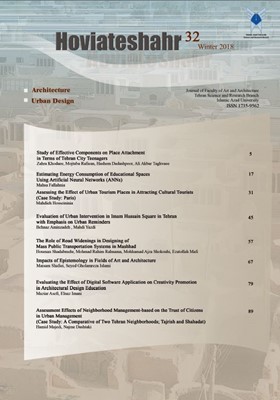Impacts of Epistemology in Fields of Art and Architecture
Subject Areas : architecturemaisam shafiei 1 , Seyed Gholamreza Islami 2
1 - دانشآموخته دوره دکتری معماری، دانشگاه آزاد اسلامی، واحد علوم و تحقیقات، تهران ، ایران
2 - استاد دانشکده معماری، پردیس هنرهای زیبا، دانشگاه تهران، ایران
Keywords: architectural understanding, recognizing patterns, Mind, sensation, imagination,
Abstract :
Cultural heritages, among which architecture and urban planning are the upmost manifestation, are not rendered tothe next generation without making effort. It is a vital prerequisite to benefit from historical remaining essences. Thefirst step in doing so is historical understanding which itself needs not only insight and perception of history of theheritages, but also their content and existential role during the history up to today. In other words we should have aperception accompanied by qualitative understanding of it throughout history which encompasses present time andfuture. Human, who is a part of boundless universe, is necessarily in need of other parts of such whole being andhas a permanent relation with them. If we consider nature, the universe without human, we can conclude that thesetwo are homogeneous and they mutually affect each other. In epistemology, human is in search of criteria for realunderstanding of the surrounding nature. Therefore epistemologists try to study human mind potentials. Cognitionin human history has been appeared as scientific and artistic cognition, through another medium. This cognitionis philosophic cognition and also cognition on information and communication. Everyone in this world is feelingtheir surrounding through the senses, and by their understanding of the world they pass the first step in cognition.Thus they have a little understanding of the universe. Through passing the second step, human can conceptualize hisperception, develop and deepen this understanding and make it more real. Generally through human’s relation to hissurrounding world and on the basis of psychology of perception, there are various ways to understand and reviewarchitectural relics. Working on and understanding architecture aid us to have better perception of human’s differentdimensions; spiritual, material and mental. Studies show that in order to have perception of architecture, firstly weshould have broad understanding of the definition of human mind framework in the process of creating the space. Itcan in itself broaden discussion in this field. In the analysis of a work of architecture together three different spacein front is detected: The cultural space developer, personal looks at the cultural space and personal cultural spacethat expressed the achievements made by the manufacturer and consumers, according to the analysis and based onthe knowledge and views of the building, understands anything of the work nature show also differ by individualquarters. This is where we can make an impact and studying the architecture of the two categories realized from eachother. Basically, there is a reciprocal relationship between critics and cognitive architecture. By concentrating on theissues in epistemology, a clear-cut method can be gained in our understanding in the fields of art and architecture.The research have been to find a definition for knowledge in the fields of art and architecture. The results of thestudies show that to achieve the recognition of architecture, first we pay attention to a holistic concept of architecturethat could broaden the field of discussion in this regard.
1. اشرافی، نسیم؛ و نقی زاده، محمد. (1394). مقایسه تطبیقی فرایند شناخت و آفرینش –با تبیین جایگاه حقیقت و ایده– در هنر معماری غربی و اسلامی. هویتشهر، 9 (23)، 37 – 46 .
2. الکساندر، کریستوفر. (1386). معماری راز جاودانگی. (مهرداد قیومی بیدهندی، مترجم). تهران: دانشگاه شهید بهشتی.
3. آگ برن، ویلیام فیلدینگ؛ و نیم کوف، مایر فرانسیس. (1388). زمینه جامعهشناسی. (امیرحسین آریانپور، اقتباس کننده). تهران: نشر گستره.
4. باوندیان، علیرضا. (1380). شناخت، شناختشناسی، شناختشناسی هنری، مجله
کیهان فرهنگی، 18 (177)، 44-50.
5. برآبادی، کاظم. (1386). معماری فرایندی خلاق. روزنامه دنیای اقتصاد،6 (1470)، 19.
6. تقوایی، ویدا. (1389). از چیستی تا تعریف معماری. هویت شهر، 5 (7)، 75 – 86 .
7. صدرالمتالهین، (1353)، فلسفه عالی با حکمت صدرالمتالهین، تلخیص و ترجمه قسمت امور عامه والهیات کتاب اسفار، نگارش محمدجواد مصلح، جلد2-1. تهران: انتشارات دانشگاه تهران.
8. کورت گروتز، یورگ. (1388). زیباییشناسی درمعماری. (جهانشاه پاکزاد و عبدالرضا همایون، مترجم). تهران: دانشگاه شهید بهشتی .
9. Colthheart, M. (1999). Modularity and cognition .Trends in Cognitive Science Journal, 3 (3),115-121
10. Craig, E. (2002). Philosophy A Very Short Introduction. New York: Oxford University Press Inc.
11 .Dara-Abrams.D . (2005). Architecture of Mind and World: How Urban Form Influences Spatial Cognition. Cognitive Studies Comps Papers .Minnesota, Northfield :Carleton College.
12. Duffy . F& Hutton. L . (2004 ). Architectural Knowledge The Idea of a Profession . New York : Taylor & Francis.
13. Heskett, J . (2002 ). Design: A Very Short Introduction . New York : Oxford University Press.
14. Kriegel, U., & Thagard, I. P. (2006). Consciousness: Phenomenal consciousness, access consciousness, and scientific practice. Handbook of philosophy of psychology and cognitive science,195-217 ,from http://www.uriahk iegel.com/downloads/concept.pdf
15. Munson , R., & Black, A. (2016). The Elements of Reasoning, Sixth Edition. Wadsworth : Cengage Learning
16. Vermaas, P., Kroes. P., Light. A., & Moore, S. (2008).Philosophy and Design From Engineering to Architecture. U.S.A : Springer Science.
17. Winters. E. (2007). Aesthetics and architecture. New York : Continuum International Publishing Group.


